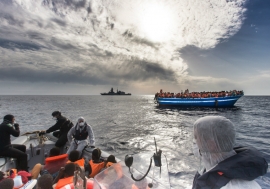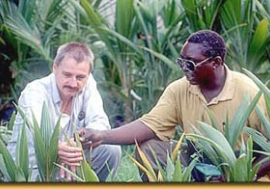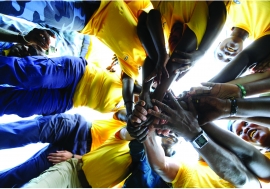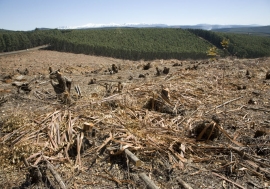Bringing water to Africa’s poor
Bringing water to Africa’s poor
 Fetching water from a river in Madagascar: Most Africans still do not have access to clean drinking water.
Fetching water from a river in Madagascar: Most Africans still do not have access to clean drinking water.Until six years ago, Eugenia Uwamahoro and several of her eight children had to trek 2 kilometres each day to a river to get about 140 litres of water for drinking, cooking, washing and feeding her four cows. There was a water pump in her village, Nyakabingo, in Rwanda’s Gicumbi district, but it hardly functioned. Then the Rwandan government, with financial support from the UN Children’s Fund (UNICEF), repaired the pump, and the community contracted a private manager to maintain it.
“It has improved my life,” Ms. Uwamahoro told African Renewal. “Now we can rest.” Not only has the pump saved her considerable time and effort, but she also gets her household’s daily water supply at lower cost than she would have from the private village water carriers who cart it up from the river.
Many villagers “are happy to pay for the improved service,” says Kamaru Tstoneste, who operates the pump. But some villagers cannot afford the cost. So community leaders compiled a list of the neediest households, and review it from time to time. “This group gets an agreed quantity of free supply,” Mr. Tstoneste told Africa Renewal. Still, he adds, “Old habits die hard. There are those who refuse to pay for water and still go to the river.”
Ms. Uwamahoro and her neighbours are fortunate. Not only do they have access to water, but they also have some choice as to its source and cost. Most Africans are not so lucky. Across the continent, half of all rural households do not have access to clean drinking water; they must rely on water sources that may be unhealthy. The situation is better in urban areas, where 80 per cent of the population is covered. Yet more than half of city and town dwellers do not have a tap in their house or yard, report the World Health Organization (WHO) and UNICEF.
The irony is that Africa has abundant fresh water: large lakes, big rivers, vast wetlands and limited but widespread groundwater. Only 4 per cent of the continent’s available fresh water is currently being used.
Distant goal
African leaders have declared their commitment to achieving universal access to clean water, through their development blueprint, the New Partnership for Africa’s Development (NEPAD), and through their support for the Millennium Development Goals (MDGs), which were adopted by world leaders in 2000.
 A communal village water tap in Ethiopia: In poor and remote rural areas, community water management may be more feasible than either public utilities or commercial companies.
A communal village water tap in Ethiopia: In poor and remote rural areas, community water management may be more feasible than either public utilities or commercial companies.The seventh MDG is to cut in half, by 2015, the proportion of people without sustainable access to safe drinking water and basic sanitation. In sub-Saharan Africa, that proportion was reduced from 52 per cent to 44 per cent between 1990 and 2004. But the target, 26 per cent, still remains very distant.
Some countries, such as Senegal, Gabon, Uganda and South Africa, are significantly increasing the number of new water connections and expanding delivery in urban areas, through both public and private investment. Senegal, reported the UN in a June 2007 assessment of progress towards the MDGs, “is on track to achieving the water and sanitation goals through a national investment programme financed with donor money.”
Africa faces a number of constraints in achieving expanded access to clean water. These include an insufficient number of skilled personnel and effective institutions. In some countries, water scarcity or pollution also pose particular challenges. The most common hindrance is the limited resources available to most countries. “Inadequate financing is the single most important factor affecting the continent’s fresh water delivery abilities,” Peter Akari, chief water policy officer of the African Water Facility at the African Development Bank (ADB), told Africa Renewal.
No single solution
From where will the money come? Donor assistance, as in Senegal, is one source. But donors are likely to provide only a portion of the estimated $5 bn needed annually to achieve the MDG target.
The UN Development Programme (UNDP) estimates that total budgetary spending in the water and sanitation sectors in sub-Saharan Africa is currently around $800 mn a year. This amount could likely be increased to $2.5 bn through “cost recovery” measures by service providers (charging users for water) and financial mobilization by local communities. Governments should also be able to increase their own budgetary allocations somewhat. In addition, a number of countries, at the urging of the World Bank and the International Monetary Fund (IMF), have sought to enlist private investment in expanding water facilities.
“There is not one single solution to ensuring everyone gains access to water,” says the UK charity WaterAid. “So it is impossible to say in general terms whether it is a good idea for private, public or community organizations to be involved in the delivery and management of services. Each circumstance should be looked at individually and a suitable pro-poor, affordable and sustainable solution found to fit each community.”
The UNDP, in its Human Development Report 2006, agrees. In seeking to expand access to clean water, the report comments: “Decisions about the appropriate public-private mix have to be taken case by case on [the basis of] local values and conditions.”
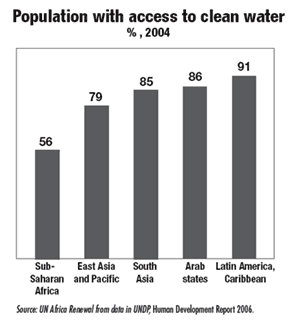
Government responsibility
Ultimately, argues Henry Ndede, a water coordinator for the UN Environment Programme (UNEP) in Nairobi, Kenya, African governments have the responsibility to reach the over 300 million people who are currently deprived of improved drinking water. Governments, he told Africa Renewal, “must put in place the right water policies to embrace the participation of the private sector in water provision. With the absence of policies, it becomes difficult.”
He cites the example of Kenya, where a water policy developed in 1999 has led to improvements in the quality of water from the country’s public system, raised revenue collection and brought more boreholes to rural communities. A 2002 water act decentralized the management of water resources and delivery. Local public companies were formed to manage water in municipalities. They largely achieved their goal of increasing the number of customers served with improved water by 50 per cent and reducing water wastage by over 40 per cent, without raising tariffs.
Some publicly owned water utilities in Africa “are efficiently run using local management structures,” notes Stephen Donkor, a senior adviser on water issues for the UN Economic Commission for Africa (ECA), headquartered in Addis Ababa, Ethiopia. Their achievements, he says, counter the negative image held by some that African public utilities are inherently inefficient and can only be improved by the introduction of private owners or contractors. What these successful public utilities “do right should be shared with their sister institutions,” in other countries, Mr. Donkor told Africa Renewal.
Yet even in Kenya, equitable access remains a challenge. “In the urban areas, the infrastructure caters for the planned, but not the unplanned, settlements,” reports the Washington-based consumer advocacy group Public Citizen. “For those in planned settlements, there is access to piped water. [But the] reliable flow of water varies from area to area.”
Cutbacks and privatization
Into the 1980s, water provision was mainly a state activity, carried out by governments through public utilities. These were financed through government budgets, relying mainly on donor support and taxes. Since they were not run on a for-profit basis, tariffs were minimal for piped connections. Some of those without house connections in towns and in some rural communities got water from public standpipes, mostly for free. But these publicly run systems left out millions of people.
Economic crisis and the austerity policies promoted by the World Bank and IMF obliged African governments to cut back spending on public utilities, including water, and in a number of cases to privatize existing facilities.
“The expectation was that the private sector, mainly multinational water companies, will come in and take over public water companies, running them as profit-making entities while investing and expanding the network,” Mr. Donkor explains. “But this wasn’t the case. Private investors did not find the water sector in Africa financially attractive. The returns were not enough to justify their investments.”
In the 1990s, foreign companies were offered greater incentives, such as tax holidays and the full repatriation of profits, in an effort to draw them into the sector. But even then, private investors generally preferred Asia and Latin America to sub-Saharan Africa.
Africa thus suffered from decades of under-investment in water facilities. Given this, and the poor management that afflicted utilities in many African countries, the largely publicly run sector could not maintain existing levels of service, let alone make new connections.
Pitfalls of ‘cost recovery’
As part of the push to promote private participation in the water sector in Africa and other developing regions, “cost recovery” became an increasingly common practice. For the private companies themselves, the application of higher water tariffs and user fees was central to turning a profit. But for the public utilities as well, increasing tariffs was also seen as a way to stem financial losses or increase resources for further investment.
For many people who never had access to piped water or had previously gotten water from private carters who charged exorbitant prices, the new tariffs may have seemed worth it. But for many of Africa’s poorest, the costs were prohibitive.
Overall, South Africa has achieved remarkable progress in expanding access to clean water. Under the old apartheid system, about one-third of the population, overwhelmingly in the country’s then-segregated black communities, did not have access to safe water. But when the African National Congress came to power in 1994, the new constitution proclaimed access to water as a basic human right. By 2004 about 88 per cent of the population had access to clean water.
As a matter of policy, all those with access to piped water are entitled to receive 25 litres per day at no charge. But beyond that threshold, users must pay, at a steeply graduated rate. Both private companies and local public water utilities have strictly enforced the cost-recovery practice, affecting poor households most severely. In 2002, the Johannesburg-based Rural Development Services Network, a non-governmental organization, estimated that some 10 million people had their water supply cut off at one point or another over the previous eight years for failing to pay their bills.
Two years earlier a major cholera outbreak swept the province of KwaZulu-Natal, killing some 300 people. Health officials found that many people in the most affected areas had resorted to using water from polluted rivers and lakes nearby, because they had been cut off from their water taps for non-payment of bills. The government responded by installing public standpipes in many low-income communities and by introducing flat low rates.
Summarizing the trade-off between expanded access and costs, the UNDP’s Human Development Report stated, “The challenge for all providers, public and private, is to extend access and overcome the price disadvantage faced by poor households.”
New management in Ghana
Ghana, in West Africa, attempted to solve its difficulties by bringing in new, outside managers for its water utility. The hope was that they would operate it more efficiently and along commercial lines.
The public water utility, the Ghana Water Company, Ltd. (GWCL), had previously been able to provide water to about half of the country’s population of 20 million. But it started losing money for a variety of reasons, including unpaid bills and illegal connections. As a result, it could not make any significant repairs or further extend the system. In 2005, officials in Accra estimated that the company lost half of its daily delivery of 450 mn litres through leakages from old pipes.
Ruby Amable of Ashongman, a middle-income residential area in Accra, was one of the utility’s many customers to lose service. The supply from her private connection worsened to three times a year, until it ran completely dry. She tried to fetch water from a neighbouring area. But that area also “hasn’t had working pipes for the past two years,” Ms. Amable told Africa Renewal. Yet she and her neighbours continue to receive regular monthly bills from the water company for simply having a connection in their homes.
To get water for her family of four, Ms. Amable had little option but to buy it from private water tanker operators. She has to spend the equivalent of $50 each month to fill her overhead tank.
At the urging of the World Bank, the government restructured the GWCL. In 2001 it increased water tariffs by more than 90 per cent. To make the GWCL more financially viable and to attract potential investors, the government also wrote off $100 mn in debts that the company owed.
In 2005, the government managed to secure a $103 mn grant from the World Bank, and bilateral donors provided an additional $17 mn. The government hoped that the fresh money would enable the GWCL to replace obsolete equipment and repair leaking pipes. It also set a goal of installing some 50,000 new household connections and 350 public standpipes by 2011 in Ghana’s main towns.
As a condition for the World Bank grant, the government had to agree to bring in a private water company to manage the GWCL. Through an international tender, Aqua Vitens Rand, Ltd. (AVRL), a joint subsidiary of two multinational water companies, Vittens of the Netherlands and Rand Water of South Africa, won a five-year management contract, and began running the GWCL’s delivery system in January 2006. Maintenance of the system and investments in new equipment and extensions continued to be the responsibility of the public company.
Nearly two years later, many customers are still looking at dry pipes. GWCL officials blame Ghana’s energy crisis, the result of low water levels in the reservoir of the Akosombo hydroelectric dam. AVRL’s managers emphasize investment problems. “The target of 50,000 new service connections is in progress, but it is slow because extension services in the target areas have not been done,” Stanley Martey, communications manager for AVRL, told Africa Renewal.
Domestic critics of the AVRL contract agree that investment is important, but go further to question the wisdom of bringing in outside managers. “The problem with Ghana’s water distribution system is not exactly that of management, but rather investment,” Steve Manteaw, an executive member of the Ghana National Coalition Against Water Privatization, told Africa Renewal . “The pipelines are old and there is a need to inject massive capital investment.”
The World Bank insists that improved management and investment are essential. “Turning around GWCL so it becomes a viable utility requires both investments and efficiency gains,” says the bank’s senior water specialist, Ventura Bengoechea. “The latter are expected as a result of the management contract, provided that the investments are made. Massive investments per se would not change the situation of the GWCL.”
Building capacity
For many African governments, the challenge is not only finding more money for vital investments. It is also acquiring the technical know-how to use the resources most effectively and the institutions capable of managing them properly.
In countries such as Uganda or Mozambique, each with a population of close to 20 million, explains Mr. Akari of the ADB, achieving the MDG goal will require installing “some 1,000 new point sources of hand-dug wells and drilled boreholes fitted with hand pumps, plus 30 piped systems every year, as well as establishing utility operators in five major cities and 15 secondary cities.”
To do that, says Mr. Akari, such countries will need professionals with the skills to plan, budget, design, supervise and construct the facilities, as well as engineering, drilling and construction equipment. In some African countries, especially those emerging from conflict, such capacity is simply not available. About a third of African countries have the capacity to implement investments, if direct financing can be secured. But in the rest, such capacity needs to be built, perhaps as a component of project financing.
Currently, explains Mr. Donkor of the ECA, “Most grants come with informal conditions attached which force African governments to hire experts — consultants, technical management and designers — from donor countries to implement the projects.” This in turn makes it hard for countries to retain national water professionals, he adds. “Leaving out local expertise in the implementation of such projects makes the water sector unattractive, compelling many of the professionals to leave.”
To address this problem, the UN-Water/Africa network — which comprises various UN agencies, the NEPAD Secretariat and the ADB — is setting up a directory of African water experts. By making it easier for such experts to serve in other African countries, the initiative will not only help foster regional integration, but also enhance the long-term maintenance of water projects in the continent.
The way forward towards achieving wider access to clean water, UN Secretary-General Ban Ki-Moon stated on 22 March, World Water Day, includes “strengthening institutional capacity and governance at all levels, promoting more technology transfer, mobilizing more financial resources and scaling up good practices and lessons learned.”









